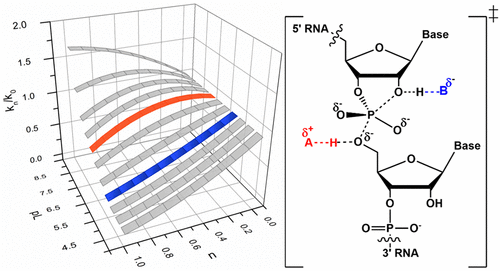当前位置:
X-MOL 学术
›
Biochemistry
›
论文详情
Our official English website, www.x-mol.net, welcomes your feedback! (Note: you will need to create a separate account there.)
Beyond the Plateau: pL Dependence of Proton Inventories as a Tool for Studying Ribozyme and Ribonuclease Catalysis
Biochemistry ( IF 2.9 ) Pub Date : 2021-09-08 , DOI: 10.1021/acs.biochem.1c00489 Suhyun Yoon 1 , Michael E Harris 1
Biochemistry ( IF 2.9 ) Pub Date : 2021-09-08 , DOI: 10.1021/acs.biochem.1c00489 Suhyun Yoon 1 , Michael E Harris 1
Affiliation

|
Acid/base catalysis is an important catalytic strategy used by ribonucleases and ribozymes; however, understanding the number and identity of functional groups involved in proton transfer remains challenging. The proton inventory (PI) technique analyzes the dependence of the enzyme reaction rate on the ratio of D2O to H2O and can provide information about the number of exchangeable sites that produce isotope effects and their magnitude. The Gross–Butler (GB) equation is used to evaluate H/D fractionation factors from PI data typically collected under conditions (i.e., a “plateau” in the pH–rate profile) assuming minimal change in active site residue ionization. However, restricting PI analysis to these conditions is problematic for many ribonucleases, ribozymes, and their variants due to ambiguity in the roles of active site residues, the lack of a plateau within the accessible pL range, or cooperative interactions between active site functional groups undergoing ionization. Here, we extend the integration of species distributions for alternative enzyme states in noncooperative models of acid/base catalysis into the GB equation, first used by Bevilacqua and colleagues for the HDV ribozyme, to develop a general population-weighted GB equation that allows simulation and global fitting of the three-dimensional relationship of the D2O ratio (n) versus pL versus kn/k0. Simulations using the GPW-GB equation of PI results for RNase A, HDVrz, and VSrz illustrate that data obtained at multiple selected pL values across the pL–rate profile can assist in the planning and interpreting of solvent isotope effect experiments to distinguish alternative mechanistic models.
中文翻译:

超越高原:质子库存的 pL 依赖性作为研究核酶和核糖核酸酶催化的工具
酸/碱催化是核糖核酸酶和核酶使用的重要催化策略;然而,了解质子转移所涉及的官能团的数量和特性仍然具有挑战性。质子库存 (PI) 技术分析酶反应速率对 D 2 O 与 H 2比率的依赖性O 并且可以提供有关产生同位素效应的可交换位点的数量及其大小的信息。Gross-Butler (GB) 方程用于从 PI 数据中评估 H/D 分馏因子,这些数据通常是在假设活性位点残留电离变化最小的条件下(即 pH 速率曲线中的“平台”)收集的。然而,将 PI 分析限制在这些条件下对于许多核糖核酸酶、核酶及其变体来说是有问题的,因为活性位点残基的作用不明确,在可接近的 pL 范围内缺乏平台,或者活性位点官能团之间的协同相互作用正在经历电离。在这里,我们将酸/碱催化的非合作模型中替代酶状态的物种分布整合扩展到 GB 方程中,2 O 比率 ( n ) 与 pL 与k n / k 0。对 RNase A、HDVrz 和 VSrz 使用 PI 结果的 GPW-GB 方程进行的模拟表明,在 pL 速率曲线中以多个选定 pL 值获得的数据有助于规划和解释溶剂同位素效应实验,以区分替代机制模型.
更新日期:2021-09-21
中文翻译:

超越高原:质子库存的 pL 依赖性作为研究核酶和核糖核酸酶催化的工具
酸/碱催化是核糖核酸酶和核酶使用的重要催化策略;然而,了解质子转移所涉及的官能团的数量和特性仍然具有挑战性。质子库存 (PI) 技术分析酶反应速率对 D 2 O 与 H 2比率的依赖性O 并且可以提供有关产生同位素效应的可交换位点的数量及其大小的信息。Gross-Butler (GB) 方程用于从 PI 数据中评估 H/D 分馏因子,这些数据通常是在假设活性位点残留电离变化最小的条件下(即 pH 速率曲线中的“平台”)收集的。然而,将 PI 分析限制在这些条件下对于许多核糖核酸酶、核酶及其变体来说是有问题的,因为活性位点残基的作用不明确,在可接近的 pL 范围内缺乏平台,或者活性位点官能团之间的协同相互作用正在经历电离。在这里,我们将酸/碱催化的非合作模型中替代酶状态的物种分布整合扩展到 GB 方程中,2 O 比率 ( n ) 与 pL 与k n / k 0。对 RNase A、HDVrz 和 VSrz 使用 PI 结果的 GPW-GB 方程进行的模拟表明,在 pL 速率曲线中以多个选定 pL 值获得的数据有助于规划和解释溶剂同位素效应实验,以区分替代机制模型.



























 京公网安备 11010802027423号
京公网安备 11010802027423号